Life
[called Curry, by George Petrie et al.]; b. 20 Nov. 1794, at Dunaha [var. Doonaha], nr. Carrigholt, Co. Clare; employed as keeper of Limerick Lunatic Asylum [mental hospital; m. Anne Broughton, dg. of John B. (Killaderry, nr. Broadford, Co. Limerick), 3 Oct. 1824; wrote a poem congratulating O’Connell on his election as MP to Co. Clare, 1828; became self-taught authority on Irish MS materials; recruited by George Petrie to topographical and historical section of Ordnance Survey under Capt. Larcom [q.v.], 1834-37; co-fnd., with John O’Donovan and others, Irish Archaeological Society, 1841 [err. 1840 DIH]; assisted M. J. Barry with Irish material in 2nd edn. of Songs of Ireland (1846); on the cessation of funding for the Ordnance Survey’s Historical Department (directed by George Petrie [q.v.] in 1835, he commenced drawing up catalogues of Irish manuscripts in the libraries of the RIA and TCD, and afterwards in the British Museum (1849-56; for fee of £100); produced transcripts edited as the Irish Annals by John O’Donovan, 1848-51; elected to RIA, 1851; mbr. Celtic Society, 1853; appt. Professor of Irish History and Archaeology in newly-founded Catholic University, 1854; his teaching from 1855 onwards published as Lectures on the MSS Materials of Ancient Irish History (Dublin 1861), giving comprehensive summary of medieval Irish manuscripts and their contents; editing translating Irish texts held in the RIA, TCD and BML in conjunction with O’Donovan, whose brother-in-law he became; |
|
|
| translated Gaelic MSS, notably Seanchus Mór (Hancock, 1865), i.e., the Brehon Laws, involving him in acrimonious relations with O’Donovan who had been appointed his nominal superior in the venture; also his handwritten facsimiles of The Genealogical Manuscript of Duald Mac Fhirbhis (1836); The Book of Lismore (1839), The Book of Lecan, and other MSS; also the posthumously issued Manners and Customs of the Ancient Irish (1873), edited by W. K. Sullivan [q.v.]; d. 30 July 1862, Dublin, of heart-attack; survived by 2 sons and 2 dgs.;bur. Glasnevin [Prospect] Cemetery]; he was called by Matthew Arnold the ‘obscure Scaliger of a despised literature’ in Arnold’s Lectures on Celtic Literature (1865-67); a photo-port was taken in 1850 [infra]. | ||
| ODNB JMC IF DIB DIW DIH DIL RAF FDA OCIL | ||
| Thomas D’Arcy Magee |
In the recess of a distant window there wa a half-bald head, bent busily over a desk, the living master-key to all this voiceless learning. It was impossible not to be struck at the first glance with the oval, well-spanned cranium, as it glistened in the streaming sunlight. And when the absorbed scholar lifted up his face, massive as because such a capital, but lighted with every kind of inspiration, it was quite impossible not to feel sympathetically drawn towards the man. There, as we often saw him in the flesh, we still see him in fancy. Behind taht desk, equipped with ink-stands, acids, and microscope, and covered with half-legible vellum folios, rose cheerfully and bouyantly to instruct the ignorant, to correct the prejudiced, or to bear with the petulant visitor, the first of living Celtic scholars and palaeographers. |
| Dublin University Magazine |
|
| —Both quoted from Alfred Webb, A Compendium of Irish Biography [1878] at Library Ireland - online; accessed 09.06.2018. |
[ top ]
Works
|
| See also ... |
|
[ top ]
Bibliographical details
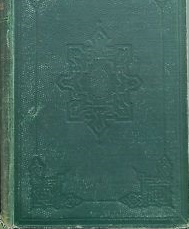
|
| ‘“It would be futile,” says 0’Curry, “to attempt to give any close and detailed account of the state of education in this country before the Christian era.”’ — Lectures, vol. ii., page 49; quoted in John Healy Ireland’s Ancient Schools & Scholars (1890) - Preface, p.[1, n.1].) |
[ top ]
| On the Manner and Customs of the Ancient Irish[...] (1873) | |||
|
|||
On the Manner and Customs of the Ancient Irish: a series of lectures delivered by the late Eugene O’Curry, MRIA, prof. Irish History and Archaeology in the Catholic University of Ireland; corresponding member of the Society of the Antiquaries of Scotland, &c., edited, with an introduction, and appendixes, &c., by W. K. Sullivan, PhD, Sec. of the Royal Irish Academy and Professor of Chemistry to the Catholic University and Royal College of Surgeons, 3 vols. (London: Williams & Norgate [London & Edinburgh]; Dublin: W. B. Kelly [8 Grafton St., Dublin]; NY: Scribner, Welford & Co. 1873). Printed by John F. Fowler, 3 Crow Street, Dame Street [Dublin] |
|||
Ded., to John Henry Newman, DD, of the oratory these volumes are inscribed in acknowledgement of what he did for the advancement of learning and the encouragement of Irish archaeology and history, as first rector of the Catholic University of Ireland. [printed John F Fowler, Crow St., Dublin]. |
|||
|
|||
|
|
||
|
|
||
|
|||
|
|||
[ top ]
Criticism
A study of O’Curry is included in Sarah Atkinson, Essays on Irish Subjects (Dublin: MH Gill 1895). See also Pádraig Ó Maidín, ‘Pages from an Irishman’s Diary: This Period Then’, in Éire-Ireland, 6, 4 (Winter 1971), pp.23-28, pp.23-24 - for discussion of The Book of Lismore.
See also Stiofán Ó Cadhla, Civilizing Ireland: Ordnance Survey 1824-1842: Ethnography, Cartography, Translation, foreword by Éamon Ó Cuív (Dublin: IAP 2007).
[ top ]
Commentary
Margaret Ann Cusack (Nun of Kenmare), Illustrated History of Ireland (2nd edn., 1868) - Chap. I: ‘A nation does not begin to write its history at the first moment of its existence. Hence, when the chronicle is compiled which first embodies its story, tradition forms the basis. None but an inspired historian can commence In principio. The nation has passed through several generations, the people already begin to talk of “old times”; but as they are nearer these “old times” by some thousands of years than we are, they are only burdened with the traditions of a few centuries at the most; and unless there is evidence of a wilful object or intent to falsify their chronicles, we may in the main depend on their accuracy. Let us see how this applies to Gaedhilic history. The labours of the late lamented Eugene O’Curry have made this an easy task. He took to his work a critical acumen not often attained by the self-educated, and a noble patriotism not often [39] maintained by the gifted scions of a country whose people and whose literature have been alike trodden down and despised for centuries. The result of his researches is embodied in a work* which should be in the hands of every student of Irish history, and of every Irishman who can afford to procure it. This volume proves that the early history of Ireland has yet to be written; that it should be a work of magnitude, and undertaken by one gifted with special qualifications, which the present writer certainly does not possess; and that it will probably require many years of patient labour from the "host of Erinn’s sons," before the necessary materials for such a history can be prepared.’
* ‘Lectures on the MS. Materials of Ancient Irish History. This work was published at the sole cost of the Catholic University of Ireland, and will be an eternal monument of their patriotism and devotion to literature. A chair of Irish History and Archaeology was also founded at the very commencement of the University; and yet the “Queen’s Colleges” are discarding this study, while an English professor in Oxford is warmly advocating its promotion. Is the value of a chair to be estimated by the number of pupils who surround it, or by the contributions to science of the professor who holds it?’ (p.39.) [The professor in Oxford is Matthew Arnold whose Lectures on Celtic Literature were given in 1865-67.] (See further under Thomas Moore, Commentary, supra.)
An American accolade: No nation has suffered so much from the “conspiracy against truth,” which is known as modern history as the Irish nation. For centuries every writer has taken his shy at Ireland, reading into her history his own prejudices, presuming that because of adverse political conditions and loyalty to a proscribed religion the Irish nation of today and yesterday has been the supply for the “huers of wood and the drawers of water” — that this nation and great ethnic family that it represents., !he Celtic, has in it no greatness and has always occupied the inferior position it today is just emerging from. [...] We have plenty of data for onr inquiry which of late years have been made the subject of close scrutiny. The manuscript remains of Ireland, more numerous than of any other European country, have given us not only a true picture of ancient Ireland but also of the great Celtic family of which Ireland is the most distinguished modern development. [...] Eugene O’Curry, in those epoch-making lectures which he delivered before the student body of the short-lived Irish university, presided over by the great English churchman, has given us ample historical data upon which to reconstruct the ancient Irish life, and the work ho so brilliantly began has been carried on till today and the A.O.H. chair of Celtic in the Catholic University of Washington will soon contribute to this great work by the publication of a critical edition of the TainBo-Cuailnge, the great Irish Illiad. ...
Rev. Edward E. Fitzgerald, “Pagan Ireland”, in Thomas Aloysius McAvoy, ed., A Course of Lectures on Ireland [Ancient Order of Hibernians] (Worcester, Mass: The Messenger 1915), pp.[17]-18; our emphasis; available at Internet Archive - online; accessed 03.05.2024].
Ernest Windisch: Eleanor Knott writes in her obituary of Windisch (1919): ‘Windisch has a high opinion of the historic value of Irish saga: “Ireland darf stolz sein aug seine alte Heldensage” (Ireland can be proud of her old heroic saga)” he writes of Táin Bó Cualnge and in the preface to Irische Texte, 1, he points out the importance of the Irish sagas as a rich, abundant source of undefiled Celticity (Celtenthum): “Welche fülle von interesssanten Zügen hat O’Curry in seinen Lectures aus dieser Quelle geschöpft, ohne sie zu erschopen!” (What an abundance of interesting traits has O’Curry in his Lectures drawn from this source, without exhausting it!)’ (‘Ernest Windisch, 1844-1918’, in Studies: An Irish Quarterly Review, June 1919, p.266.)
Knott remarks in a footnote - ‘O’Curry’s work in this field [Irish sagas] cannot, in some respects, be over-rated. Windisch himself obviously found it of value; but the German scholar’s work has more exactitude and caution. These qualities had not much chance of flourishing in the atmosphere in which the great native scholar worked. Windisch remarks, more in sorrow than in anger: Die einheimischen Gelehrten haben ohne Anstoss Alles überstetzt, als wenn Schwierigkeiten gar nicht vorhanden wären (The native scholars have translated everything fluently, as though there were no difficulties at all)’ - and adds in the following footnote one that some letters from Windisch expressing surprise at the lack of native scholars to carry on the work of translation can be found in the Life of Sir John Gilbert, ed. by Lady Gilbert. (Ibid., p.265.)
W. B. Yeats, “A General Introduction for my Work” (1937): ‘[...] O’Leary had sent me to O’Curry, but his unarranged and uninterpreted history defeated my boyish indolence.’ (Essays & Introductions, London: Macmillan 1961, p.511.)
Seán O’Faoláin : O’Faoláin writes of The Book of Invasions: ‘The nineteenth-century scholars such as Eugene O’Curry, took this volume as more or less genuine history; it is a measure of modern Irish scepticism that its latest critic roundly describes it as “a work of fiction”. Its compilers set out to ... unify the country politically by giving all the contemporary upper classes a common Gaelic origin [&c.]. (See The Irish, 1947, Chap. 1: ‘The Great Gods Die’, p.18).
George A. Little, Dublin Before the Vikings (Dublin: M. H. Gill 1957), derives varied points of argument for the Gaelic origins of Dublin from O’Curry. Item I: Eiscir Riada alternative name for Slighe Mór, meaning Chariot Esker, since riada or riata ‘always signifies riding on horseback or in a chariot, e.g., Carbat chethat riad always means a chariot with four horses ... This Eiscir ... Slighe Mór, or the Great Road or Highay, had the addition of Riada made to it because of its adaptation to, and adoption as, a riding or chariot-driving way from the West of Eirinn to Tara and the Eastern coast, and is said in the Dinnseachus to have been first discovered, or used as a roadway, by Nar, son of Aengus of Umhall ...’ (O’Curry, Battle of Magh Leana, scholium p.69) [51] Item II: Battle of Magh Léna, ed. O’Curry, mentions Ath Cliath Duiblinne in the long form. Item III: O’Curry’s translation of The Battle of Magh Léna; ‘It was at this time that Mogha Nuadat went upon the great circuit of his own half of Eire, until he reached Ath Cliath Dubhlinne, and having gone there to see the port of the ships, he found that more vessels came to Conn’s part of the harbour than to his. Mogha was consequently stung with great envy; and he said he would not abide by the co-division that had been already made, unless he got an equal division of the horses, and arms, and armour, and of the profits of the sea [fish] and the great tides [flotsam and jetsam]; and he sent a message demanding this co-division from [sic] Conn. Conn answered that he never would place arms nor clothes, nor armour, under the same rule of division as territory; and Mogha on hearing this threw up his truce without delay, turned back to Munster again, and told his foreigners (Spaniards) how he had received cause of quarrel from Conn; and French and his warriors were well pleased to hear that speech ...’ (O’Curry’s ed., p.71). [89] Item IV: In his introduction (p.15), O’Curry writes, ‘That the Battle of Magh Lena and the battles and political movements which preceded it in Eire and which led to the division of the country between Conn and Mogha are genuine historical facts, must be admitted from the frequent reference to them in ancient Gaedhilg or Irish manuscripts, and their having been received and handed down as such by descendants of the contending parties even to the present day.’ [90] Item V: O’Curry cites the partitioning of Ireland, presumably in his ed. of Catha Magh Lena [?copied in] Book of Ballymo[t]e, Book of Leacon [sic], Book of Leinster, also in MS TCD, Class H.e., 18, p.567. [166] Item VI: O’Curry, Manners and Customs of the Ancient Irish, intro. Prof. Sullivan, p.107, characterises the parts of a tulachán by its separate parts, Tulchin (flat top of mote); iarom (garth); mur (rampart); fordorus (sallyport); aurland (sloping way to gate), all these showing Irish familiarity with motes. [170].
[ top ]
Quotations
Manners and Customs (1873, Lecture XIX (Vol. III): ‘[...] In dealing with this subject I shall naturally go back first to the very earliest colonists of ancient Erinn; and in doing so, I must premise by repeating the caution I have already intimated, - that here again I asopt the number and succession of these colonists, as I have hitherto done, simply in the order in which I find them in the ancient “Book of Invasions”; becuase the time has not yet come for entering on the consideration of the grounds upon which those ancient acounts have been, or to what extent they ought to have been, so implicitly relied on by the Gaedhelic writers of the last eighteen hundred years. Without at all then entering at present into any investigation of the [1; and note erroneous lefthand footer: Vol.II.] long discussed question of the veracity of our ancient records and traditions, which declare that this island was occupied in succession by the Partalonians, the Nemedians, the Firbolgs, the Tuatha Dé Danann, and, finally, the Milesians or Scoti; or from what countries or by what routes they came hither; it must strike every unprejudiced reader as a very remarkable fact, that the Scoti, who were the last colony, and consequently the historians of the country, should actually have recorded, by name and local position, several distinct monuments, still existing, of three out of the four peoples or races who are said to have occupied the country before themselves. And although much has been incautiously written of the tendency of our old Scotic writers to the wild and romantic in their historical compositions, I cannot discover any sufficient reason why they should concede to their predecessors the credit of being the founders of Tara, the seat of the monarchy, as well as of some others of the most remarkable and historic monuments of the whole country, unless they had been so. / Etymological speculations and fanciful collations of the ancient Gaedhelic with the Semitic languages, were taken up by a few very incompetent persons in this country within our own memory, and carried to such an extent of absurdity, that both [the] subject and the authors became a bye-word among the truly learned historians and philologists of Europe. Still, etymology and philology must have an important bearing on the ethnological history of Europe. It forms, however, no part of my present plan to enter upon any arguments based on these studies; though I may of course have occasion now and again to refer to proofs or illustrations ascertained by their means.’ (pp.1-2.)
| Manners Customs of the Ancient Irish (London: Williams & Norgate; Dublin W. B. Kelly 1873) | ||
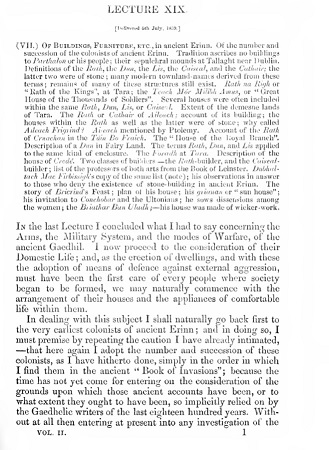
|
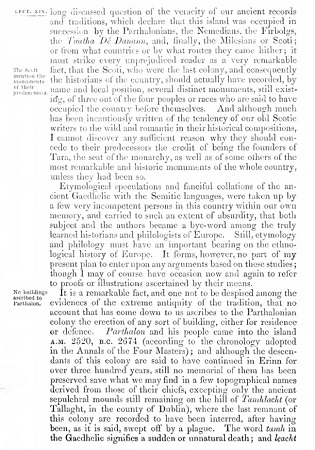
|
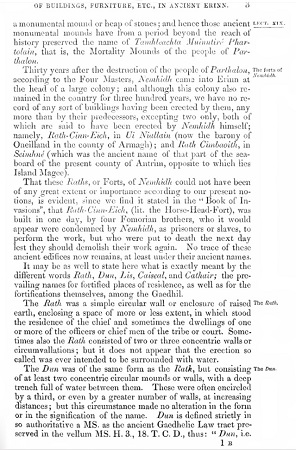
|
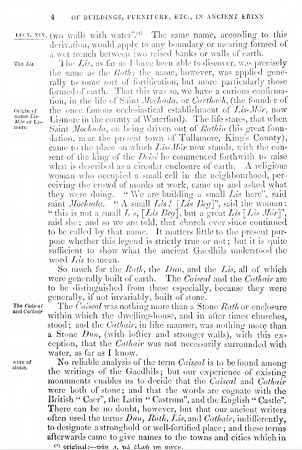 |
[...] | 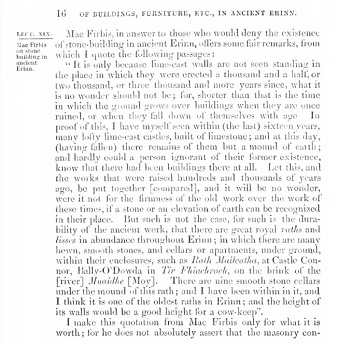 |
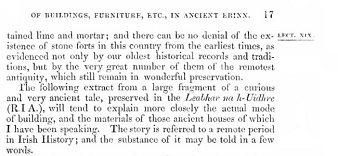 |
||
On the Manner and Customs of the Ancient Irish: a series of lectures delivered by the late Eugene O’Curry, MRIA [...] ed. with an introduction, and appendix, &c., by W. K. Sullivan, PhD, Sec. of the RIA, and Professor of Chemistry to the Catholic University and Royal College of Surgeons, 3 vols. (London: Williams & Norgate; W B Kelly; NY: Scribner, Welford & Co. 1873). |
||
| [See Table of Contents - supra.] | ||
[ top ]
On Music & dancing: ‘It is strange, and will, I am sure, appear to my readers almost incredible, that, as far as I can ever read, there is no reference that can be identified as containing a clear allusion to dancing in any of our really ancient MS books.’ Further: O’Curry’s reproves his contemporaries in Ireland: ‘Why have we banished to contempt and poverty the ever good-humoured and often talented ... wandering professors of this, the proudest inheritance of our ancient heritage?’ And ‘Oh, why do not Irishmen cultivate, encourage, cherish and hoard up in their innermost souls the priceless treasure of ... their matchless music ... .’ (See Preface, Allen Feldman with Eamonn O’Doherty, The Northern Fiddler, Blackstaff Press 1979.
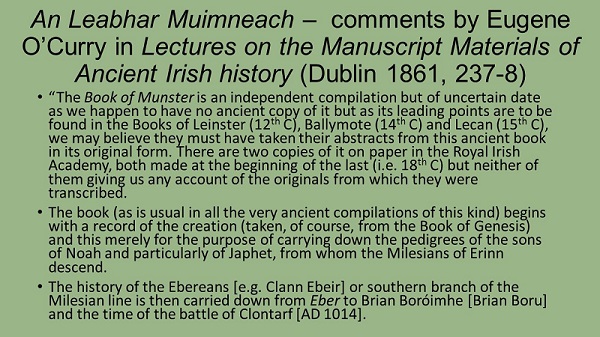
|
MS Letter (NLI) |
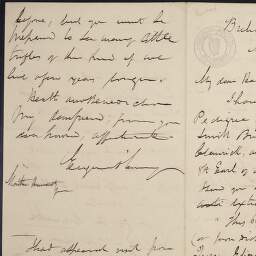 |
[ top ]
Seamus Deane, gen. ed., The Field Day Anthology of Irish Writing (Derry: Field Day 1991), Vol. 1, cited by anonymous author of ‘Our Periodical Literature’ (1845), 1268; also, 1268n characterises him as editor and translator of Irish texts and professor of Irish history and archaeology in the Catholic University of Ireland from 1854 [sic]; no other references to O’Curry in this volume. Vol. 2, Mangan’s acquaintance with, 6; Mr Curry, in Petrie’s notes to ‘The Lament of Richard Cantillon’, 77; Petrie acknowledges O’Curry as his source of ‘The Pearl of the White Breast’ [‘Péarla’], 82; Petrie employs him [biog.], 206; ‘O’Curry found people within seven miles of Dublin who never heard English in their youth at all’ (Douglas Hyde, in Necessity, &c, 531; ‘The importance of the work of Eugene O’Curry, John O’Donovan, Whitley Stokes, Standish Hayes O’Grady, can scarcely be overstated. With these scholars stands George Petrie’ (Thomas MacDonagh, Literature in Ireland, 1916), p.990, and ftn, O’Curry was a self-educated scholar and antiquarian who became professor of Irish history and archaeology in 1855 [sic]. See also Vol.1, p.1268+n: the passage is an anonymous article on periodicals and antiquarianism in which O’Curry figures in a list quoted from ‘the last University Magazine’ in a censorious review of an article in ‘a new literary periodical’ [unnamed in FDA] ‘on Druids and Druidism [which had] endeavoured to revive the nonsensical fancies of Vallancey and his school of imaginary antiquarians, which we had hoped the labours of Petrie, O’Donovan, Todd, and Eugene O’Curry, the Irish scribe and interpreter of the nineteenth century, and other investigators, had long dispelled.’ Vol.3, p.572n, The Seanchus Mór, the great compendium of ancient Irish law, resisted all scholarly and antiquarian investigations until finally deciphered and translated by Eugene O’Curry and John O’Donovan, whose ed. was published in 1865 by WN Hancock. [O’Curry is listed as O’Curray in the Vol.3 Index.]
Patrick Rafroidi, Irish Literature in English (Gerrards Cross: Smythe 1980) cites centenary articles by Micheál Ó hAodha in The Irish Times, also D. Ryan, The Sword of Light.
Robert Welch, ed., Oxford Companion to Irish Literature (OUP 1996) records that Matthew Arnold characterised O’Curry in his lectures On The Study of Celtic Literature, as the ‘obscure Scaliger of a despised literature’.
Booksellers: Three Geese (Cat. 1999) lists the Ancient Laws of Ireland [The Senchus Mor], including the Book of Achill and Brehon Law Tracts, with glossary [&c.], 6 vols. (Dublin: Thom 1865). Emerald Isle Books, 1995 lists Lectures on the Manuscript Materials of Ancient Irish History (Dublin: James Duffy 1861), 722pp.
Libraries: Belfast Linen Hall Library holds Manners and Customs of the Ancient Irish (1873). Belfast Public Library holds Lectures on the Manuscript Material of Ancient Irish History (1878); On the Manners and Customs of the Ancient Irish, 2 vols. (1873). University of Ulster Library (Morris Collection) holds Lectures on the Manuscript Material &, delivered at the Catholic University of Ireland during the Sessions of 1855 and 1856 (Kelly 1873) 722p.
[ top ]
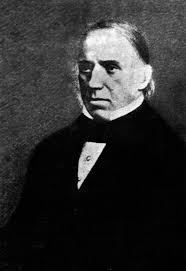
|
Saddest news: Dr William Reeves wrote to Sir John Gilbert in 1862: ‘The news in your telegram yesterday was the saddest news I have received for a long time. Eugene O’Curry’s death is more lamentable than that of O’Donovan. When O’Donovan died we still had 10s in the pound; but now we can only look forward to utter poverty. Poor Ireland has lost the last scholar, indeed the only scholar she had ... A little time ago the field of Irish literature was being tilled, and the sun shone on it, but now I think a heavy blanket of fog has come down and darkened it.’ (Quoted in Eamonn de hOir, Seán Ó Donnabháin agus Eoghan Ó Comhraí, Dublin 1962, p.114; cited in Robert Welch, A History of Verse Translation from the Irish 1789-1897, 1988, p.146.)
Ordnance work: Curry reached Enniskerry in Dec. 1838 and ‘proceeded without delay to learn the pronunciation of the townland names of the parish of Powerscourt .. hoped that Larcom would furnish quills, paper, pencils and sealing wax.’ (“Irishman’s Diary”, Irish Times, q.d., 2001.)
Gerald Griffin: O’Curry wrote archaeological notes on the Danes for Gerald Griffin’s The Invasion (Dublin: James Duffy [1832]).
W. B. Yeats: The source of Yeats’s poem “The Madness of Goll”, so noted by Yeats himself, is O’Curry’s Lectures on the MSS Materials of Ancient Irish History (2nd edn. 1878), p.316. (See A. N. Jeffares, A New Commentary to the Poems of W B Yeats (1988), p. 9).
Roger McHugh, ed., Carlow in ’98: Autobiography of William Farrell of Carlow (Dublin: Browne & Nolan 1949), writes: ‘the author [of the autobiography] is the son of a successful journeyman tailor, and of good descent, as he knows by finding his pedigree accounted in Eugene O’Curry’ [here Curry] (p.1.)
Archive: The O’Curry Collection in Maynooth holds two add. manuscript copies of Merriman’s Cúirt Mhean Oiche. (See T. F. O’Rahilly’s review of Cúirt an Mheadhón Oidhche, eag. Riseárd Ó Foghludha [1912], in Gadelica, Vol. I, 1912-13, p.203 n.
.jpg) |
| Memorial Plaque at Dunaha, Co. Clare (Co. Clare Library) |
Portrait: There is a portrait of O’Curry by Frederick Burton represented in company with Sir Sam. Ferguson, and this was received by the National Gallery of Ireland from among the possessions of Henry Stokes (See Anne Crookshank, ed., Irish Portraits Exhibition [Catalogue], Ulster Museum 1965).
[ top ]

